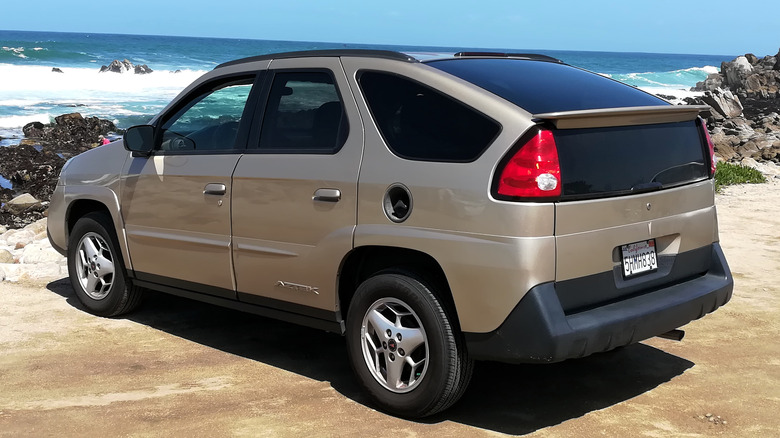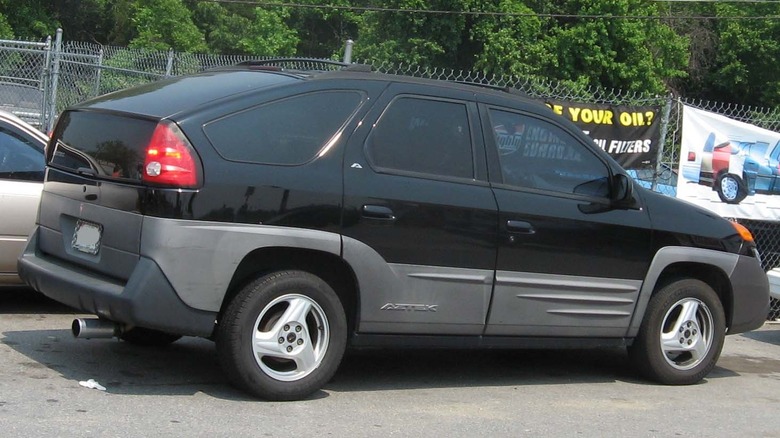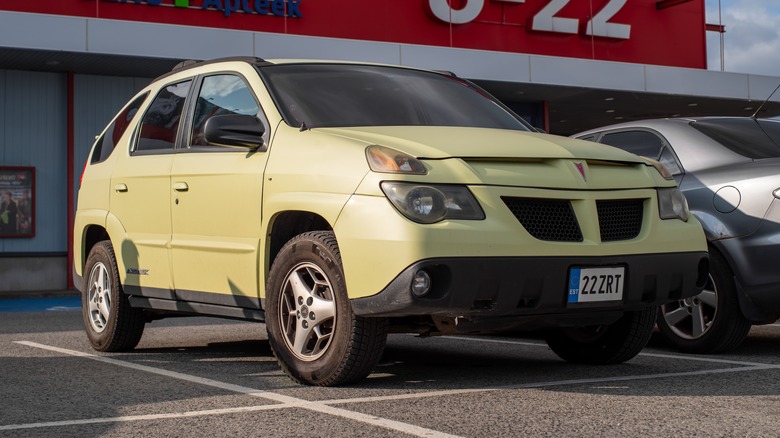Was The Pontiac Aztek Actually Ahead Of Its Time?
The Pontiac Aztek is often derided as an industry lowlight. It was produced from 2001 through 2005 and is cited by some as one of the reasons Pontiac went under in 2009. Time listed it as one of the 50 worst cars of all time, calling it "a bulky, plastic-clad mess" and "deformed and scary." SlashGear's Alex Hevesy documented how the Aztec's design-by-committee approach produced the strange beast, saying it was seemingly "created by a team of aliens that had never seen another SUV before."
Less than 120,000 were sold in its four-year run, but a starring role in "Breaking Bad" as Walter White's daily driver made the Aztek cool again about a decade ago. In 2015, it was the sixth-most frequently purchased vehicle by adults aged 18-34, according to Edmunds. The Aztek's casting as White's primary vehicle was likely meant to illustrate his lack of judgment, but in hindsight, the much-maligned crossover is looking more like a vehicle that simply arrived too soon to be appreciated and less like a hideous flop.
[Featured image by Alexander Migl via Wikimedia Commons|Cropped and scaled|CC-By 4.0]
Many modern cars imitate the Aztec's design
The Aztek was stuck in the then-empty void between SUVs and sedans that has since become crowded with crossovers like the Subaru Crosstrek and Mazda CX-30. The 2024 versions of both of those models feature the same generous lower-body plastic cladding as the Aztek. The Pontiac's toothy front end resembles that of the 2023 Jeep Compass, a crossover we rated highly upon its release. Two-plus decades ago, the motoring public wasn't receptive to the Aztek's charms, but its design elements have become commonplace in the intervening years.
The Aztek was also car-camping ready ahead of the camper van craze, with a removable cooler between the front seats and stereo controls in the rear cargo area. For $195, buyers could add a camping package that included a custom-fit inflatable air mattress and a tent that enclosed the cargo space with the hatch open.
[Featured image by IFCAR via Wikimedia Commons|Cropped and scaled|Public Domain]
The Aztec's interior had some advanced electronics
The Aztek's tent was a far more elegant design than the disappointing Tesla Cybertruck Basecamp, which costs nearly $3,000. The Aztek wasn't as off-road capable as the Crosstrek or Compass is today, but all-wheel drive was available as a $2,000 add-on (about $3,600 in 2024 money). The tailgate portion of the rear hatch was transparent for added rearward visibility and was hinged separately from the liftgate, so it could be used as a bench or table.
Aside from the Aztek's forward-leaning readiness as an overlanding vehicle, it had some other features that were fairly advanced for the time. The $365 towing package option included the air compressor and a load-leveling rear suspension, and the driver could customize the information shown on the dashboard or optional heads-up display. Rear seat passengers could watch DVDs and listen to audio via dedicated headphone jacks, and the Aztek's 9.2 second zero to 60 time was on par with other SUVs of the day thanks to the 185 horsepower, 3.4 liter V6.
So when you add it all up, perhaps the Pontiac Aztek wasn't such a crazy idea. It just arrived 20 years too early...and looked a little goofy.


